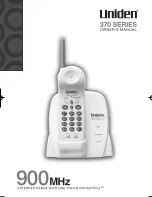
36
5. Avoid limiting the cooling function by covering the cooling slots. Do not use power tools near heat
sources or flammable surfaces.
6. Never open the charger. In the event of a fault, contact a workshop.
7. Make sure the outside of the battery is clean and dry before inserting the rechargeable battery into
the charger.
SAFETY WARNING BATTERY
1. When charging is complete, immediately remove the battery from the charger.
2. Never attempt to charge a damaged battery.
3. Do not charge the non-charging battery.
4. Incorrect use of the battery may result in overheating, explosion, or self-extinguishing and may
cause serious injuries.
5. When using rechargeable batteries, ensure the correct polarity.
6. Do not short-circuit the positive and negative contacts (eg wire).
7. When transporting or storing, the accumulator battery must be properly packed and protected
from short circuit between contacts.
8. Do not puncture, crush, and protect the battery from other mechanical damage.
9. Direct brazing on a rechargeable battery is prohibited.
10. Protect the battery from water and moisture.
11. Do not disassemble the battery and do nothing to change it. The rechargeable battery is equipped
with various safety devices. Damage to one of these safety devices may result in overheating,
explosion, or self-extinguishing of the rechargeable battery.
12. Do not place the battery pack near naked flames, stoves and other heat sources. Keep the battery
pack away from direct sunlight and do not leave or use it in your car in good weather.
13. If the rechargeable battery is not used, it should be charged at about 30-50% and stored at room
temperature. When prolonged storage, the rechargeable battery must be recharged once a year to
prevent complete discharge.
14. Charge the rechargeable battery at room temperature. Otherwise, the battery may be seriously
damaged or its service life may be reduced. Do not charge the battery in the vicinity of acids and
flammable materials.
15. The rechargeable battery and the charger heat up during the charging process. This is normal and is
not considered a defect.
16. If the rechargeable battery does not charge during the specified charging time, it should not be
continued during the charging process. Otherwise, the rechargeable battery may heat up, explode,
or ignite itself.
17. Insulate the recessed rechargeable battery by wrapping the contacts with adhesive tape or similar.
18. When disposing of the battery, do not burn it or dispose it in normal waste. Dispose used
rechargeable battery packs at your local collection yard or recycling facility.
19. If unusual smell, overheating, color or shape changes or other abnormalities occur during charging /
discharging, immediately discontinue the use of the rechargeable battery.
20. If leaked fluid from the battery pack leaks into the eye, do not rub it, but flush with plenty of water
and seek immediate medical attention. If not treated, fluid from the battery may damage the eye.
21. Before first use, the rechargeable battery must be charged. The rechargeable battery reaches full
capacity only after several charging and discharging cycles.
22. Charge the rechargeable battery only in the chargers that are determined by the manufacturer.
Other errors may occur or may result in fire when using another charger.








































